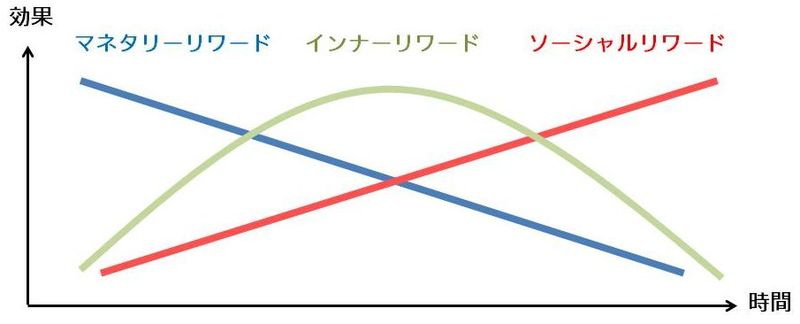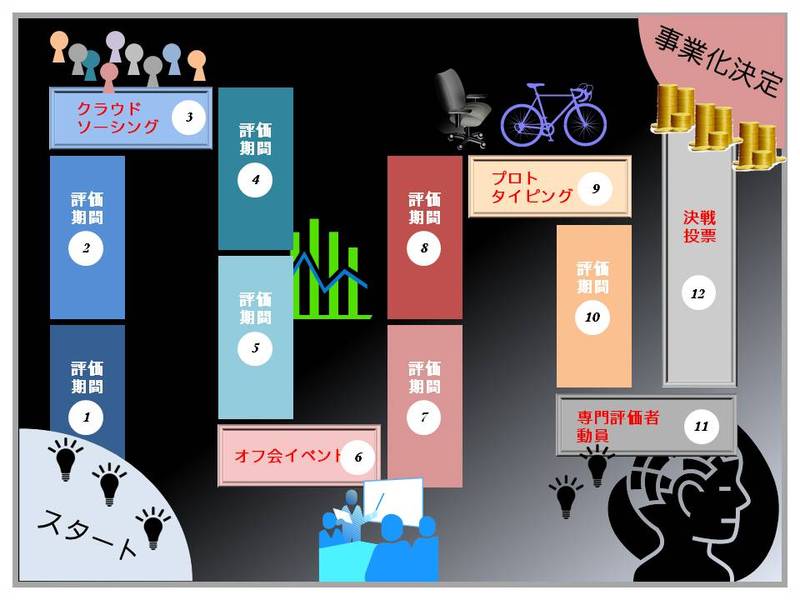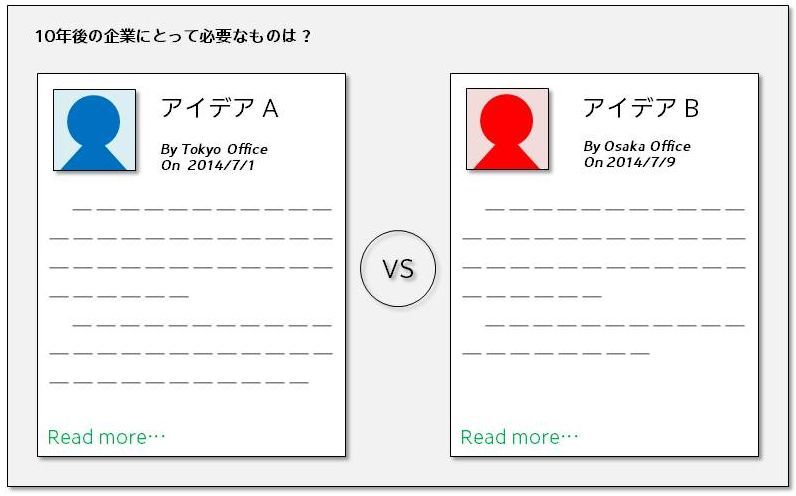Hello. I'm Akihiro Shimura from the Consulting Department, Marketing Design Bureau, Dentsu Kansai Branch. Following the second installment, this time I'll discuss the actual flow of network-based innovation using innovation management tools and related topics.

The overall innovation management flow from an implementation perspective is divided into five stages: Plan ⇒ Design ⇒ Mobilize ⇒ Launch ⇒ Manage. As explained in the second installment, all stages except Launch fall under the role of the Innovation Management Office ( IMO ). This time, we will focus primarily on Launch (the actual emergent activities) and examine the specific points the IMO should fulfill.
Reading the Movements During Emergence Before Implementation
Typical online ideation activities occur on the Innovation Management Tool explained in the first session. This tool is structured like a social networking site within the ideation site (the company's intranet, internal or external portal site). During the ideation period, participants post ideas on this site, evaluate others' ideas, refine their own ideas, and continuously improve them.
The emergent site displays reference materials and initiative objectives to facilitate idea generation. Its content evolves alongside idea development, adapting to participants' circumstances. This familiar, user-friendly structure, combined with automated mass screening, eliminates operational complexity.
However, even IMO staff who constantly think about innovation management cannot grasp the individual conditions of every employee. No matter how thoroughly you plan the story during the ideation process, ideas and people's actions change constantly every day, and situations can arise that are completely different from what was anticipated. To prevent this, IMO operates by recursively deciding various matters, as introduced in Part 2. Even so, it remains difficult to foresee everything.
However, there is a method to predict certain movements within any population: reward design. Rewards in emergent activities broadly fall into three categories: "Monetary Rewards," "Inner Rewards," and "Social Rewards."
・Monetary Rewards: Directly tied to money (redeemable points, prizes, discount coupons, etc.)
・Inner Rewards: Rewards tied to personal consciousness (related to self-actualization, a sense of accomplishment, etc.)
・Social Rewards: Rewards tied to interactions with others or society (honor, praise, social status, etc.)
During the emergence phase, the rewards that resonate with participants shift over time in the following order: Monetary Rewards → Inner Rewards → Social Rewards.
"Monetary Rewards" are the most effective reward for getting a large number of people to participate (at least initially) in emergent activities. They contribute tremendously to addressing the primary question busy employees have about participating in open innovation: "Why do I have to participate in such an initiative?" Unlike outdated, one-off initiatives like suggestion boxes, innovation management can sustain emergent activities once participants enter the space, thanks to these three rewards. This means it can be used more strategically than the "monetary rewards" typically found in standard idea contests.
For example, participants initially drawn by monetary rewards like "Get XX!" will gradually shift their value focus toward inner rewards once they submit an idea and receive feedback from others. The more feedback they receive, the more their mindset evolves—they begin wanting their ideas to be recognized and to refine them into more robust concepts. At IMO, we enhance this "inner reward" by integrating dedicated idea evaluators into the innovation management tool.
Then, as the emergence phase nears its end and idea quality improves, participants' focus shifts again toward "social rewards" – the desire to prototype their ideas and test them in society, seeking recognition. IMO must clearly communicate an attractive blueprint, such as promising support from the company along the lines of "When your idea hits the market..."

Thus, it is crucial to design the story carefully, ensuring the timing of at least these three rewards is not misplaced, and to anticipate participant and idea movements as much as possible before implementation.
Participants Who Act Unpredictably
Even if you manage the overall story during emergent activities, intensely engaged participants may include "innovation management hackers" who attempt to circumvent the system. Overly strong gamification elements can become a double-edged sword.
Here, "hacking" refers to participants deducing the conditions for advancing to the next stage—often based on the stage-gate approach (※1) used in some innovation management tools—and then sharing these insights with other participants.
Two methods are effective in suppressing such hacks. One is the participation and information sharing by an authoritative figure (e.g., the CEO). If the CEO or a senior leader is actively involved in the emergent process itself, it becomes difficult for participants to engage in truly unorthodox behavior.
The other is presenting the entire initiative as a single, comprehensive picture before various speculations arise. As you may have noticed, innovation management initiatives are complex, making this 'single picture' crucial. Companies in Europe and the US often put tremendous effort into creating this single picture. (Of course, we cannot show an actual single picture used in practice.) For example, it might look something like this.

In practice, by framing the mortar-like structure described in Session 2 —from one tank to another—as the overall picture and constantly sharing it with participants, you can help them recognize their current state. Since ideas, people, and innovation are all living entities, understanding the present state provides significant reassurance.
The Relationship Between Innovation and Equal Opportunity
It's not just the idea owner's actions that are unpredictable. Whether intentional or not, no one can control the content of an idea or the timing of its submission. Despite this, the mass screening function—the greatest strength of innovation management tools—automatically screens ideas. Naturally, this situation leads to several problems.
A common scenario involves similar ideas being submitted at different times. Since innovation management is a process that follows ideas through implementation, if ideas are similar, the one with more follow-ups (≈ more supporters) or endorsements at the time of submission becomes the implementation lead. This is because, barring exceptional circumstances, innovation rarely happens through one person (or a small group). In this sense, it does not presuppose equal opportunity.
However, what about the feelings of the idea owner who conceived a similar idea first? In such cases, we integrate the ideas. Operationally, before starting the ideation activity, we clearly state the rules for when identical ideas are posted (including the fundamental rule to search for existing ideas before posting). We then ask the owner of the idea that advances to become a follower of the winning idea. Of course, idea owners can mutually agree on a primary/secondary relationship. Alternatively, if the organizer's intent is strong from the outset, a wildcard (※2) can be pre-set. This approach naturally unites like-minded individuals through ideas, forming a stronger, more cohesive structure for implementation.
Another scenario occurs when hundreds of thousands of ideas are emerging simultaneously. At certain moments, dozens or even hundreds of ideas are submitted at once, causing some to get buried. This means they never get evaluated by others, leading to even greater dissatisfaction than in the previous case. That's where the Pairwise Evaluation feature comes in.
Pairwise evaluation randomly selects two ideas from all previously submitted ones and asks users to rate them as A or B. This feature allows ideas submitted during periods of coincidentally high volume to be rescued. If an idea receives any action (in this case, an evaluation), the innovation management tool can display that idea at the top of the screen. This naturally brings it to the attention of other participants, allowing it to enter the normal cycle of evaluation activities.
|

|
| Image of the Pairwise Evaluation Screen |
During the actual emergence period, users engage in many unpredictable behaviors, and numerous unforeseeable ideas emerge. Thus, the "public opinion absorbing diversity" can truly be described as a living entity. IMO constantly grasps these waves of innovation and recursively navigates the actual emergence activity, the Launch phase.
Moving forward, we will depart from the overview covered thus far and delve into applied topics. These include idea inventory and idea stretching techniques , methods for forming grassroots supporters to aid IMO , innovation through outer × inner networks, and more advanced screening methods. We look forward to your continued interest.
(Continued in Part 4 and beyond)
※1 Stage-Gate Method: A method that screens ideas from one stage to the next using gates with defined clearance criteria.
※2 Wildcard: A special category not selected through the standard extraction framework.






